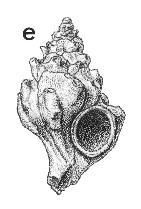
Revised descriptions of New Zealand Cenozoic Mollusca from Beu and Maxwell (1990)

 | Revised descriptions of New Zealand Cenozoic Mollusca from Beu and Maxwell (1990) | 
|
  (Pl. 37e): holotype, GS2661, T24/f7399, tributary of Awapikopiko Stream, near Awapikopiko Road (Druce Road on T24), c. 3 km south of Kumeroa, southern Hawke's Bay, Waipipian (TM3140, GNS) |
Beu & Maxwell (1990): Chapter 14; p. 296; pl. 37 e.
Synonymy: Typhis tepunga (sic) Fleming 1943, p. 205; Typhis (Neotyphis) tepungai of Vella 1961, p. 385; Siphonochelus (Laevityphis) tepungai, Beu & Maxwell 1990, p. 296, pl. 37e.
Type species of Neotyphis Vella, 1961 (synonymised with Laevityphis Cossman, 1903 by Gertman 1969)
Classification: Muricidae: Typhinae
Description: Small for family (20-22 mm high), relatively tall and narrow for subfamily, smooth apart from growth lines, and hollow tubes characteristic of subfamily; spire equal to height of aperture and canal. Varices high and rounded, sloping slightly backward, with prominent shoulder formed by a short, upward-pointing tube; weakening rapidly across sutural ramp; 4.5 per whorl (18 in 4 whorls). Upper part of varix (above weak lower angulation produced by the upper of 2 small, accessory tubular spines lower on varix) almost vertical. A large tubular spine on shoulder angle halfway between each pair of varices, directed almost vertically upward and a little backward, weakly linked to succeeding varix by low ridge from its shoulder spine, and linked to suture by prominent ridge extending from front edge of intervariceal spine. Aperture small, oval, with thick, raised, continuous peristome; anterior canal moderately long (longer than aperture), a fused tube directed slightly to left, with prominent fasciole formed of bases of former anterior canals. Protoconch relatively large, smooth, of 1.5 whorls, with a bulbous apex.
Comparison: The narrow shape with almost parallel whorl sides and the strongly upward-directed spines show that this (the type species of Neotyphis Vella, 1961) is a species of Laevityphis (Gertman 1969, p . 171). In the presence of small accessory tubes on the varices it resembles such species as Siphonochelus parisiensis (d'Orbigny) (Eocene, Paris Basin) and S. fistulosus (Brocchi) (Pliocene, Italy). The superficially similar living species S. solus Vella is very small (8 mm high) and narrowly fusiform, with smooth varices lacking all tubular spines, and perhaps belongs in Lyrtotyphis Jousseaume, 1880, near the living Australian species L. syringianus (Hedley). We know of no other closely related New Zealand species. Adoption of Laevityphis as a genus follows Maxwell (2009, p. 246).
Distribution: Opoitian-Waipipian; "Takapau faunule", tributary of Awapikopiko Stream near Awapikopiko Road (Druce Road on NZMS 260 map sheet T24), c. 3 km south of Kumeroa, southern Hawke's Bay, Waipipian (type); uncommon but widely distributed in shelf facies sandstone and mudstone with diverse, scattered Mollusca in the Wairoa district, northern Hawke's Bay, and in the Dannevirke-Takapau district, southern Hawke's Bay.
Cite this publication as: "A.G. Beu and J.I. Raine (2009). Revised
descriptions of New Zealand Cenozoic Mollusca from Beu and Maxwell (1990). GNS
Science miscellaneous series no. 27."
© GNS Science, 2009
ISBN
978-0-478-19705-1
ISSN 1177-2441
(Included with a PDF facsimile file
copy of New Zealand Geological Survey Paleontological Bulletin 58 in CD version
from: Publications Officer, GNS Science, P.O. Box 30368 Lower Hutt, New
Zealand)